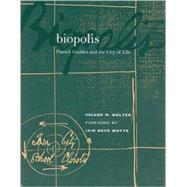
Biopolis Patrick Geddes and the City of Life
by Welter, Volker M.Buy New
Rent Textbook
Used Textbook
We're Sorry
Sold Out
eTextbook
We're Sorry
Not Available
How Marketplace Works:
- This item is offered by an independent seller and not shipped from our warehouse
- Item details like edition and cover design may differ from our description; see seller's comments before ordering.
- Sellers much confirm and ship within two business days; otherwise, the order will be cancelled and refunded.
- Marketplace purchases cannot be returned to eCampus.com. Contact the seller directly for inquiries; if no response within two days, contact customer service.
- Additional shipping costs apply to Marketplace purchases. Review shipping costs at checkout.
Summary
Author Biography
Table of Contents
| List of Illustrations | p. VIII |
| List of Tables | p. XIII |
| Acknowledgments | p. XIV |
| Foreword | p. XVI |
| Introduction | p. 1 |
| "Angling for Cities!" | p. 6 |
| The Scientist of Life | p. 9 |
| The Economics of Nature | p. 13 |
| The Economics of Cities | p. 16 |
| The Order of Cities | p. 17 |
| The Revolt against Reason | p. 19 |
| Toward a Larger Modernism | p. 22 |
| Patrick Geddes's Theory of the City | p. 26 |
| Victorian Britain and Historical Models | p. 28 |
| The Notation of Life | p. 31 |
| From Individual to Communal Psychology | p. 40 |
| Geddes's Theory of the City: A Platonic Reading | p. 46 |
| The City and Geography | p. 54 |
| Town and Country | p. 55 |
| The Valley Section | p. 60 |
| Edinburgh and Its Region: A Northern Athens and Its Polis | p. 66 |
| The Region-City: A Step toward Conurbations and the World City | p. 70 |
| Regional and Universal | p. 76 |
| The Outlook Tower | p. 78 |
| The City in History | p. 82 |
| The City in Nineteenth-Century Thought | p. 84 |
| Geddes's View of History: The Arbor Saeculorum | p. 88 |
| Organicism and Morphology | p. 92 |
| The Cities and Town Planning Exhibition | p. 99 |
| Some Problems, Regional and Historical | p. 103 |
| History in the City | p. 106 |
| Reading History from the City | p. 108 |
| The Genius Loci | p. 112 |
| Conservative Surgery | p. 116 |
| The Rebuilding of Crosby Hall | p. 120 |
| Exhibitions for Learning | p. 124 |
| Recapitulation and Recollection | p. 131 |
| The Metaphysical Imperative in Urban Design around 1900 | p. 136 |
| Building the Ideal Community | p. 138 |
| Temple Ideas around 1900 | p. 145 |
| Temples of Art and Culture | p. 159 |
| Temples of the City | p. 168 |
| The City and Spirituality | p. 174 |
| The Temple of Geography | p. 176 |
| Biological Views of the City: Eugenic and Metabolic | p. 187 |
| The Temple of the Greek Gods: A Temple of Life | p. 192 |
| The Garden for the Nine Greek Muses: Life in Action | p. 197 |
| The Temple as the Union between Science and Religion | p. 200 |
| A Hall of Vision | p. 206 |
| From the Temple of the City to the Cultural Acropolis | p. 214 |
| The Temple of the City | p. 215 |
| Celebrating the City | p. 221 |
| The Cultural Acropolis | p. 232 |
| The City Crown | p. 244 |
| Epilogue | p. 250 |
| Synoptic Overview of Geddes's Life and Time | p. 256 |
| Notes | p. 268 |
| Bibliography | p. 314 |
| Illustration Credits | p. 342 |
| Index | p. 346 |
| Table of Contents provided by Ingram. All Rights Reserved. |
An electronic version of this book is available through VitalSource.
This book is viewable on PC, Mac, iPhone, iPad, iPod Touch, and most smartphones.
By purchasing, you will be able to view this book online, as well as download it, for the chosen number of days.
Digital License
You are licensing a digital product for a set duration. Durations are set forth in the product description, with "Lifetime" typically meaning five (5) years of online access and permanent download to a supported device. All licenses are non-transferable.
More details can be found here.
A downloadable version of this book is available through the eCampus Reader or compatible Adobe readers.
Applications are available on iOS, Android, PC, Mac, and Windows Mobile platforms.
Please view the compatibility matrix prior to purchase.
